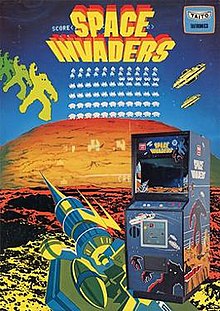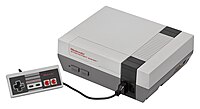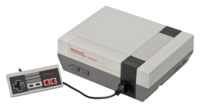-
Use Cases
-
Resources
-
Pricing
Early Consoles
Spacewar! influences arcade game creation
1962
% complete
Eventually displays with rudimentary vector displays for graphics were available, leading to titles like Spacewar! in 1962.
Image source: Spacewar!

Computer Space, the first recognized arcade game, is created
1971
% complete
Spacewar! directly influenced Nolan Bushnell and Ted Dabney to create Computer Space in 1971, the first recognized arcade game.
Image source: Computer Space

Concept of home consoles founded
1972
% complete
The concept of home consoles used to play games on a television set was founded by the 1972 Magnavox Odyssey, first conceived by Ralph H.
Magnavox Odyssey, the first home video game console, is released
1972
% complete
Separately, while at Sanders Associates in 1966, Ralph H. Sanders patented the unit and licensed the patents to Magnavox, where it was manufactured as the first home video game console, the Magnavox Odyssey, in 1972.
Image source: Magnavox Odyssey

Atari forms and releases Pong
1972
% complete
He and Dabney formed Atari, Inc., and with Allan Alcorn, created their second arcade game Pong, first released in 1972 which was more successful than Computer Space.
Image source: Pong

Atari releases Pong console through Sears
1975
% complete
Atari released a Pong console of its own design through Sears in 1975.
Mattel releases handheld electronic game Auto Race and Football
1977
% complete
The first such handheld electronic game was released by Mattel in 1977, where Michael Katz, Mattel's new product category marketing director, told the engineers in the electronics group to design a game the size of a calculator, using LED technology." This effort lead to the 1977 games Auto Race and Football.
Image source: Mattel Auto Race

Milton Bradley releases Simon handheld electronic game
1978
% complete
Another Ralph Baer invention, Simon, published by Milton Bradley in 1978, followed, which further popularized such electronic games and remained an enduring property by Milton Bradley (later Hasbro) that brought a number of copycats to the market.
Image source: Simon (game)

Milton Bradley releases Microvision handheld video game console
1979
% complete
Milton Bradley's Microvision, released in 1979, is often considered the first such handheld video game console, as well as the first handheld to use interchangeable games, though the unit never caught on due to short-term technical struggles.
Image source: Microvision

Nintendo introduces Game & Watch titles
1980
% complete
Nintendo's line of Game & Watch titles, first introduced in 1980, was based on inspiration from Gunpei Yokoi after seeing a man playing on an LCD calculation while passing time on a bullet train, and had devised the idea of an electronic game that doubled as a watch.
Image source: Game & Watch

Console Generations
First home console, Magnavox Odyssey, released
Sep 1972
% complete
The first home console was the Magnavox Odyssey in September 1972 based on Baer's "Brown Box" design.
Atari launches Pong console
1975
% complete
Atari had successfully launched Pong as an arcade game in 1972, and began work to make a home console version in late 1974, which they eventually partnered with Sears to release the new home Pong console by the 1975 Christmas season.
Coleco introduces Telstar console
1976
% complete
Coleco developed the first Telstar console in 1976. With Magnavox, Atari, and Coleco all vying in the console space by 1976 and further cost reductions in key processing chips from General Instruments, numerous third-party manufacturers entered the console market by 1977 with ball-and-paddle games. This led to market saturation by 1977, and the industry's first market crash.
Image source: Coleco Telstar series

Fairchild Video Entertainment System introduces ROM game cartridge
Nov 1976
% complete
While ROM cartridges had been used in other computer applications prior, the ROM game cartridge was first implemented in the Fairchild Video Entertainment System (VES) in November 1976.
Image source: Fairchild Channel F

Nintendo collaborates with Mitsubishi
1977
% complete
Nintendo had already been a business partner with Magnavox by 1971 and helped to design the early light guns for the console. Nintendo became a major player when Mitsubishi, having lost their manufacturer Systek due to bankruptcy, turned to the company to help continue to build their Color TV-Game line, which went on to sell about 3 million units across four different units between 1977 and 1980.
Image source: Color TV-Game

Atari 2600 version of Space Invaders released
1980
% complete
Game developments coincided with the Golden age of arcade video games that started in 1978-1979 with the releases of Space Invaders and Asteroids, and home versions of these arcade games were ideal targets. The Atari 2600 version of Space Invaders, released in 1980, was considered the killer app for home video game consoles, helping to quadruple the console's sales that year.
Image source: Space Invaders

North American home console market crashes
1983
% complete
Along with competition from inexpensive home computers, the North American home console market crashed in 1983. For the most part, the 1983 crash signaled the end of this generation as Nintendo's introduction of the Famicom the same year brought the start of the third generation.
Image source: Video game crash of 1983
Nintendo introduces Famicom
1983
% complete
When Nintendo brought the Famicom to North America under the name "Nintendo Entertainment System", it helped to revitalize the industry, and Atari, now owned by Jack Tramiel, pushed on sales of the previously successful Atari 2600 under new branding to keep the company afloat for many more years while he transitioned the company more towards the personal computer market.
Image source: Nintendo Entertainment System

Atari 2600 discontinued
1992
% complete
The Atari 2600 stayed in production until 1992, marking the end of the second generation.
Image source: Atari 2600

Third generation of consoles ends
2003
% complete
For example, the third generation is considered to end in 2003 with the formal discontinuation of the Nintendo Entertainment System that year.
Image source: Third generation of video game consoles

Handheld Consoles
Nintendo releases Game Boy
1989
% complete
While the Game & Watch series were considered handheld electronic games rather than handheld video game consoles, their success led Nintendo, through Yokoi's design lead, to produce the Game Boy in 1989, considered to be the defining basis of the current handheld game console.
Image source: Game Boy

Nintendo releases Game Boy Advance
2001
% complete
Nintendo continued to refine its Game Boy design with the Game Boy Advance in 2001, including its Game Boy Advance SP in 2003 and Game Boy Micro in 2005, all with the ability to link to the GameCube to extend the functionality of certain games.
Image source: Game Boy Advance

Sony introduces PlayStation Portable (PSP)
2004
% complete
Sony introduced its PlayStation Portable (PSP) in 2004, a revised version of the PSP but eliminating the use of external media and focusing on digital acquisition of games, as well as incorporating a touchscreen.
Image source: PlayStation Portable

Modern Consoles
Apple launches App Store
2008
% complete
Simple games such as Tetris and Solitaire had existed for PDA devices since their introduction, but by 2009 PDAs and phones had grown sufficiently powerful to where complex graphical games could be implemented, with the advantage of distribution over wireless broadband. Apple had launched its App Store in 2008 that allowed developers to publish and sell games for iPhones and similar devices, beginning the rise of mobile gaming.
Image source: App Store (Apple)

Nintendo releases Wii U
2012
% complete
The Wii U, introduced in 2012, was considered by Nintendo to be a successor to the Wii but geared to more serious players.
Image source: Wii U

Microsoft releases Xbox Series X and Series S
Nov 2020
% complete
Both Microsoft and Sony released successors to their home consoles in November 2020. Microsoft released the fourth generation of Xbox with the Xbox Series X and Series S on November 10, 2020.
Image source: Xbox Series X and Series S

Sony releases PlayStation 5
Nov 2020
% complete
Both Microsoft and Sony released successors to their home consoles in November 2020. Sony's PlayStation 5 was released on November 12, 2020, and also is a similar performance boost over the PlayStation 4.
Image source: PlayStation 5

Key Facts
- The first commercially successful video game console, the Magnavox Odyssey, was released in 1972.
- Nintendo revolutionized the gaming industry with the release of the Nintendo Entertainment System (NES) in 1985.
- The Sony PlayStation was introduced in 1994, becoming one of the most popular and influential consoles of all time.
- Microsoft launched the Xbox in 2001, competing directly with Sony and Nintendo.
- The current generation of consoles includes the PlayStation 5, Xbox Series X, and Nintendo Switch.
Source
This History of Video Game Consoles timeline was generated with the help of AI using information found on the internet.
We strive to make these timelines as accurate as possible, but occasionally inaccurates slip in. If you notice anything amiss, let us know at [email protected] and we'll correct it for future visitors.
Create a timeline like this one for free
Preceden lets you create stunning timelines using AI or manually.
Customize your timeline with one of our low-cost paid plans
Export your timeline, add your own events, edit or remove AI-generated events, and much more
Free
$
0
free forever
No credit card required.
Basic
$
10
/month
billed annually
Cancel anytime.
Pro
$
16
/month
billed annually
Cancel anytime.
Common Questions
Can I cancel anytime?
Yes. You can cancel your subscription from your account page at anytime which will ensure you are not charged again. If you cancel you can still access your subscription for the full time period you paid for.
Will you send an annual renewal reminder?
Yes, we will email you a reminder prior to the annual renewal and will also email you a receipt.
Do you offer refunds?
Yes. You can email us within 15 days of any payment and we will issue you a full refund.
What if I have more questions?
Check out our pricing docs or send us an email anytime: [email protected].